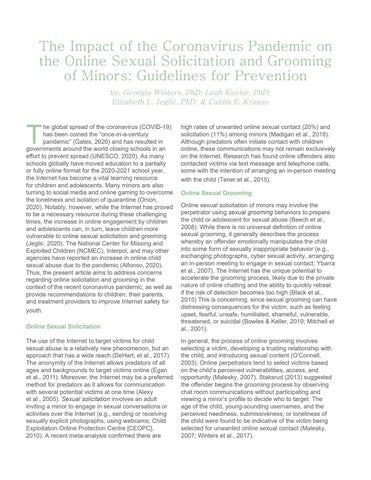The Impact of the Coronavirus Pandemic on the Online Sexual Solicitation and Grooming of Minors: Guidelines for Prevention by, Georgia Winters, PhD; Leah Kaylor, PhD; Elizabeth L. Jeglic, PhD; & Caitlin E. Krause
T
he global spread of the coronavirus (COVID-19) has been coined the “once-in-a-century pandemic” (Gates, 2020) and has resulted in governments around the world closing schools in an effort to prevent spread (UNESCO, 2020). As many schools globally have moved education to a partially or fully online format for the 2020-2021 school year, the Internet has become a vital learning resource for children and adolescents. Many minors are also turning to social media and online gaming to overcome the loneliness and isolation of quarantine (Onion, 2020). Notably, however, while the Internet has proved to be a necessary resource during these challenging times, the increase in online engagement by children and adolescents can, in turn, leave children more vulnerable to online sexual solicitation and grooming (Jeglic, 2020). The National Center for Missing and Exploited Children (NCMEC), Interpol, and may other agencies have reported an increase in online child sexual abuse due to the pandemic (Alfonso, 2020). Thus, the present article aims to address concerns regarding online solicitation and grooming in the context of the recent coronavirus pandemic, as well as provide recommendations to children, their parents, and treatment providers to improve Internet safety for youth.
high rates of unwanted online sexual contact (20%) and solicitation (11%) among minors (Madigan et al., 2018). Although predators often initiate contact with children online, these communications may not remain exclusively on the Internet. Research has found online offenders also contacted victims via text message and telephone calls, some with the intention of arranging an in-person meeting with the child (Tener et al., 2015). Online Sexual Grooming
Online Sexual Solicitation
Online sexual solicitation of minors may involve the perpetrator using sexual grooming behaviors to prepare the child or adolescent for sexual abuse (Beech et al., 2008). While there is no universal definition of online sexual grooming, it generally describes the process whereby an offender emotionally manipulates the child into some form of sexually inappropriate behavior (e.g., exchanging photographs, cyber sexual activity, arranging an in-person meeting to engage in sexual contact; Ybarra et al., 2007). The Internet has the unique potential to accelerate the grooming process, likely due to the private nature of online chatting and the ability to quickly retreat if the risk of detection becomes too high (Black et al., 2015) This is concerning, since sexual grooming can have distressing consequences for the victim, such as feeling upset, fearful, unsafe, humiliated, shameful, vulnerable, threatened, or suicidal (Bowles & Keller, 2019; Mitchell et al., 2001).
The use of the Internet to target victims for child sexual abuse is a relatively new phenomenon, but an approach that has a wide reach (DeHart, et al., 2017). The anonymity of the Internet allows predators of all ages and backgrounds to target victims online (Egan et al., 2011). Moreover, the Internet may be a preferred method for predators as it allows for communication with several potential victims at one time (Alexy et al., 2005). Sexual solicitation involves an adult inviting a minor to engage in sexual conversations or activities over the Internet (e.g., sending or receiving sexually explicit photographs, using webcams; Child Exploitation Online Protection Centre [CEOPC], 2010). A recent meta-analysis confirmed there are
In general, the process of online grooming involves selecting a victim, developing a trusting relationship with the child, and introducing sexual content (O’Connell, 2003). Online perpetrators tend to select victims based on the child’s perceived vulnerabilities, access, and opportunity (Malesky, 2007). Staksrud (2013) suggested the offender begins the grooming process by observing chat room communications without participating and viewing a minor’s profile to decide who to target. The age of the child, young-sounding usernames, and the perceived neediness, submissiveness, or loneliness of the child were found to be indicative of the victim being selected for unwanted online sexual contact (Malesky, 2007; Winters et al., 2017).












